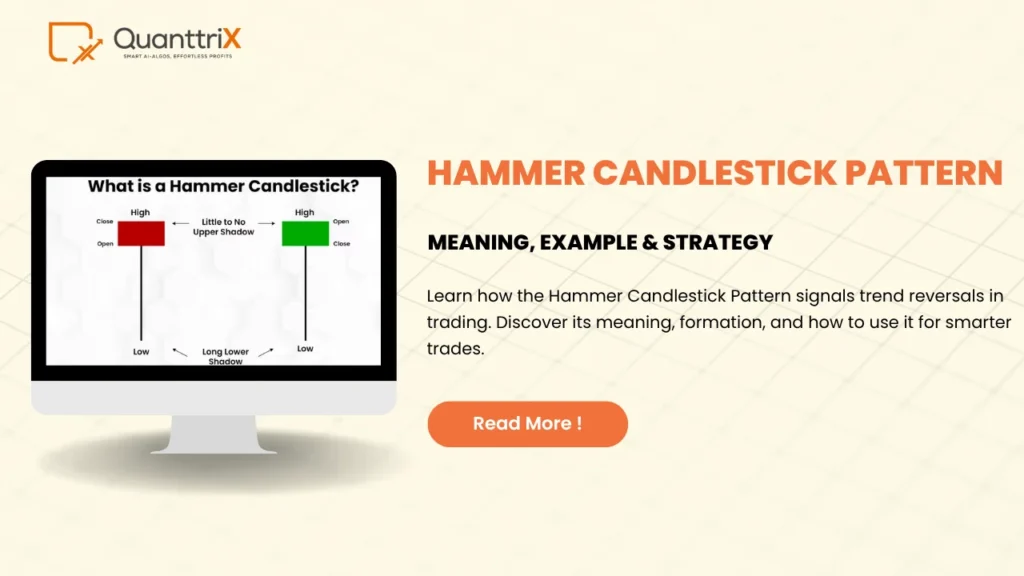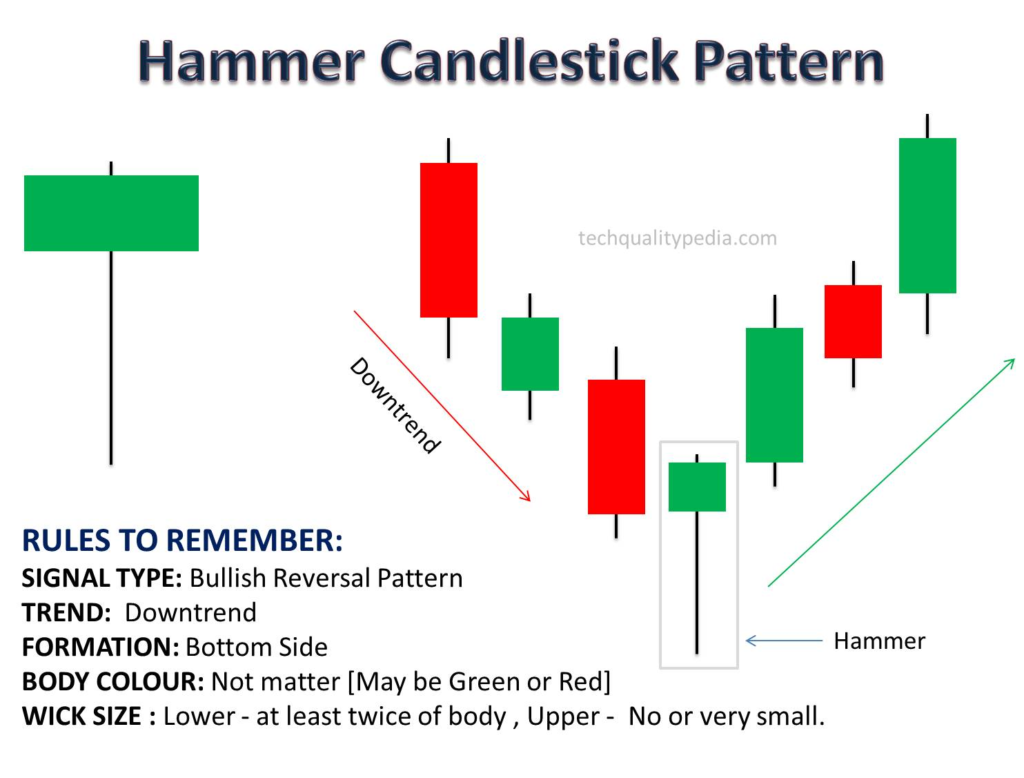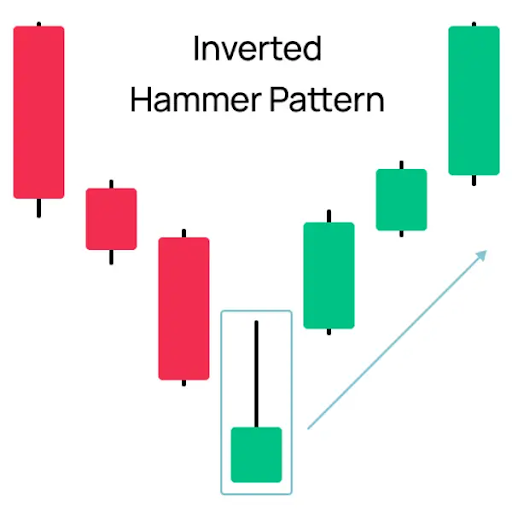
Hammer Candlestick Pattern: Meaning, Example & Strategy
When one first observes the stock market charts, the coloured bars also known as candle sticks can seem overwhelming and confusing. But some shapes just pop out , differentiating them from other candles. These shapes hint towards change in trend before even traders can identify it themselves. The hammer candlestick pattern is one of the vital clues. In this guide, one will grasp what it means, how they can be identified and how to implement its different types including the most vital inverted hammer candlestick pattern and the less common double hammer candlestick pattern and why becoming a master of these shapes makes one a smarter and better trader.
What Is a Hammer Candlestick Pattern?
- The hammer candlestick pattern is a single bullish signal usually found at the end of a downtrend.
- Its “handle” is a short real body at the top, and the “head” is a long lower shadow (tail) at least twice the size of the body.
- In simple words: The price fell during the session but bounced back up before closing. This shows buyers started to fight back.
Why does this shape matter?
It suggests selling pressure is slowing and buyers may be ready to push prices higher. But this only becomes useful if the pattern forms after a clear drop, not just at random.

Breaking Down the Hammer: Core Features
Part | Description |
Real Body | Small, near the candle’s top; can be green or red |
Lower Shadow | Long—at least double the real body; no upper shadow |
Location | Must show up after a clear downtrend |
Note: Both green and red hammers could possibly indicate reversals, but if green, the bullish sign is considered stronger.
The Inverted Hammer Candlestick Pattern: What Is It?
Unlike the standard hammer, the inverted hammer candlestick pattern has the wick on top:
- Small body at the base with a long upper shadow.
- No/very tiny lower shadow.
- Appears after a downtrend.
- Shows that bulls tried hard to push price up but sellers pushed back. Still, the first sign of buyers returning is there.
How to trade it?
One must wait for the next candle to close above the inverted hammer before deciding to execute a trade—confirmation is key.

Double Hammer Candlestick Pattern: What Makes It Special?
You might see two hammers show up back-to-back at the bottom of a falling chart. This is the double hammer candlestick pattern.
- Two sessions in a row have hammer (or inverted hammer) shapes.
- Suggests even stronger buyer interest—sellers are likely running out of steam.
- Next bullish candle boosts the odds of an upside bounce.
Again, waiting for follow-up price action is essential; never rush in on these patterns alone!
Why Candlestick Patterns Like Hammers Matter
- They are easy to spot but powerful—especially for beginners needing visual clues.
- Work on stocks, forex, crypto, and even commodity charts.
- The more times one identifies a hammer after a drop, the more natural it is to act on it—when confirmation aligns with it.
Candlestick patterns gives us the emotional story of buyers and sellers, making them helpful for all timeframes.
How to Use the Hammer Candlestick Pattern (Step-by-Step)
Step 1: Check if a clear downtrend came before the hammer.
Step 2: Find a hammer shape—tiny body up top, long thin tail beneath.
Step 3: Watch next session’s candle—see if it closes higher (bullish confirmation).
Step 4: If confirmed, consider entering a trade. Use the lowest point of the hammer as a stop-loss.
Step 5: Don’t just rely on look—add support levels, trend lines, or volume for more support.
Example Scenario
Suppose shares of Company X have dropped for several days. You spot a hammer candlestick pattern forming at ₹100, with a long lower shadow showing it dipped lower but finished strong. If the next day’s candle rises, you could buy in, putting your stop loss just below that recent low for safety.
Mistakes to Avoid
- Don’t trade only based on one hammer—wait for a second, bullish candle for proof.
- Hammers in sideways (range) markets don’t mean much—focus on clear, downtrending moves.
- Doubtful volume? Weak volume hammers are less reliable.
- Always set your risk protection—a stop-loss just under the hammer’s low.
How Does the Hammer Compare With Other Candlestick Patterns?
Let’s see a side-by-side:
Pattern | Shape | Signal Location | Meaning |
Hammer | Short body, long lower wick | After downtrend | Bullish reversal |
Inverted Hammer | Short body, long upper wick | After downtrend | Possible reversal—needs confirmation |
Hanging Man | Like hammer but after uptrend | Uptrend | Warning for trend to reverse downward (bearish) |
Double Hammer | Two hammers in a row | After sharp falls | Even stronger bullish signal, still needs confirmation |
Candlestick Patterns: Everyday Uses
- Short-term traders identify hammers on 5/15-min charts for quick reversals.
- Investors check daily or weekly charts for longer-term signals.
- Can use alongside support/resistance, RSI, or moving averages for even better accuracy.
Quick Comparison Table: Hammer Patterns and Their Signals
Pattern | Best Seen After | Main Signal | Confirmation Needed? |
Hammer | Downtrend | Bullish reversal | Yes |
Inverted Hammer | Downtrend | Bounce likely | Yes |
Double Hammer | Big downturn | Stronger rebound | Yes, very important |
Hanging Man (opposite) | Uptrend | Fall ahead | Yes, for safety |
Extra Tips for Success
- The more times you see a hammer at previous support, the more powerful the signal.
- Don’t forget to use alerts or chart tools to spot these shapes automatically.
- Combine your candlestick patterns study with basic money management for long-term success.
Common Myths
- Any hammer shape is a buy signal! – False; context and confirmation matter most.
- Green hammers are always better than red ones – Green shows stronger buying, but both work if price confirms.
- Pattern never fails – Never risk all your capital on one sign; use as part of an overall strategy.
Conclusion:
The hammer candlestick pattern is a classic indication that a price that is falling may reverse, especially when there is an additional confirmation by the inverted hammer candlestick pattern, or one gets really lucky and spots a double hammer candlestick pattern. Becoming a master of these and other candlestick patterns turns one from a plain guesser into a professional trader who can identify the mood of the market . One must always look for confirmation, set their stop loss and combine the signals with other basics of trading for execution of smarter and safer trades.
Also Read : How to Open Demat Account Online in India
FAQ'S
Can I use the hammer candlestick pattern on any time chart?
Yes—daily, hourly, and even minute-based charts can show hammers, but higher timeframes are more reliable.
What does the inverted hammer candlestick pattern mean?
It hints buyers are pushing back after a fall, but proof comes only if the next candle rises.
Is the double hammer candlestick pattern rare?
It’s not common but when it appears, it adds strength to the reversal sign—especially with rising volume.
Are these candlestick patterns good for beginners?
Absolutely! Hammer patterns are among the easiest to spot and learn.


